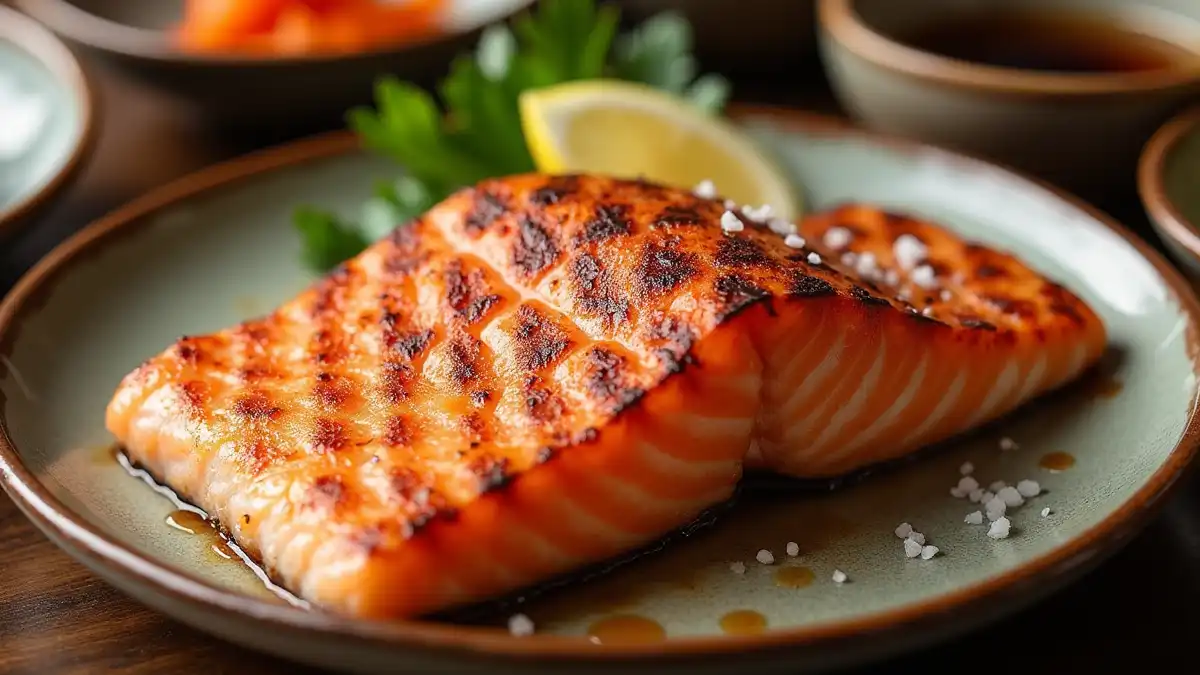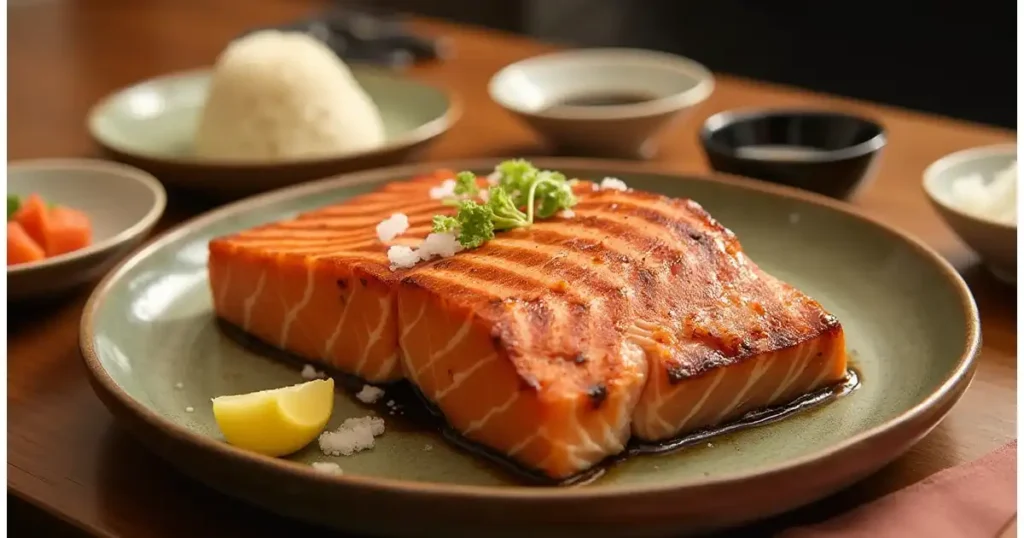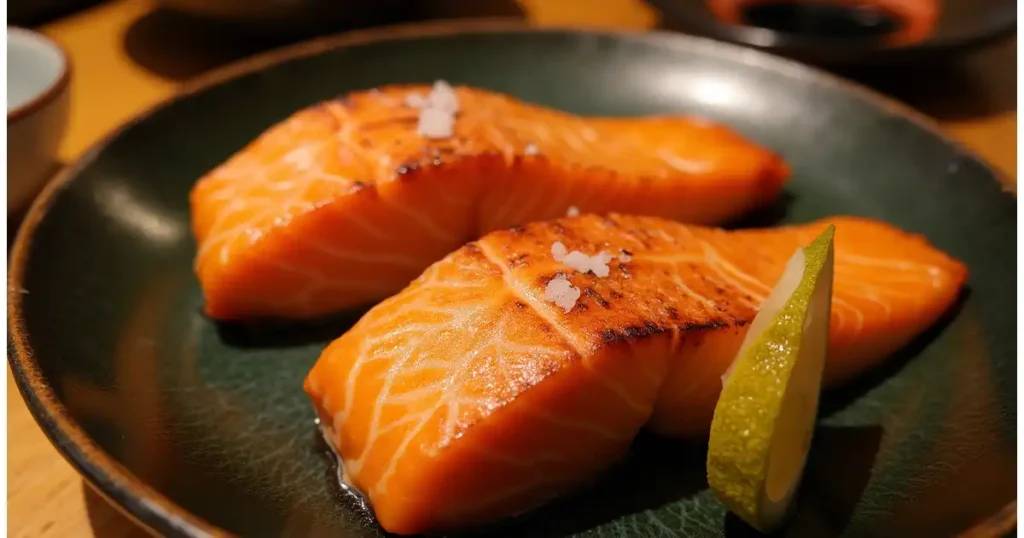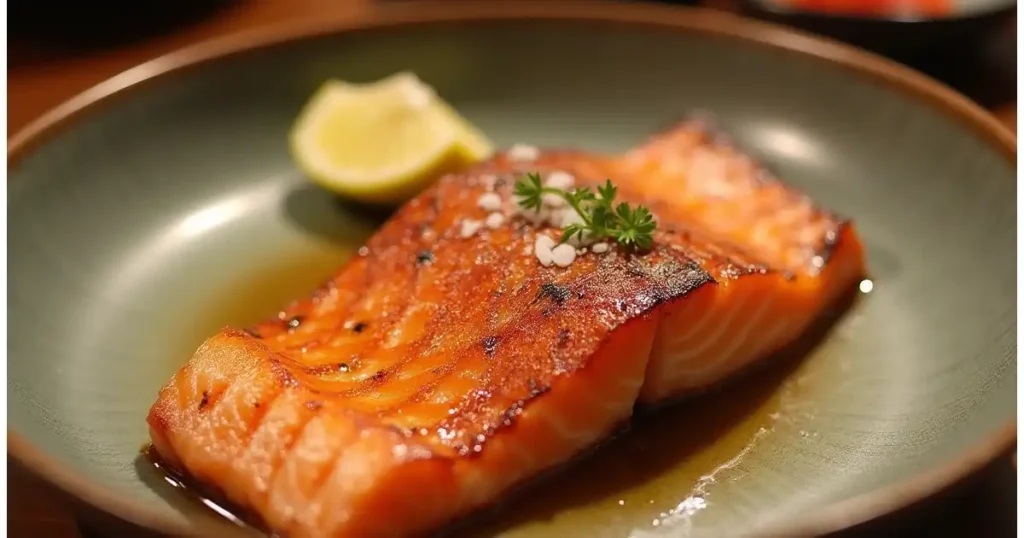
Table of Contents
Introduction
The Best-Kept Secret in Japanese Cuisine: Why Salmon Kama Should Not Be Ignored
Salmon-kama, the collar of the fish, is quite possibly the best-kept secret in Japanese cuisine. Just as fillet and steak tend to dominate the collar, few are aware of its rich taste, and it is a delicacy reserved for seafood aficionados and chefs alone. With a perfect balance of rich fat content and tender flesh, salmon-kama offers a taste experience without equal.
How This Delicious Cut Can Change Your Seafood Life
You haven’t lived until you’ve tried salmon kama. Its rich texture and down-to-earth umami flavor are a winning combination, broiled, baked, or grilled. Adding this unsung favorite to your dinner plate will bring your seafood life into a new dimension and expose you to a whole new school of thought regarding salmon.

What is Salmon Kama?
The Anatomy of Salmon Kama: Where it’s From and Why it’s So Special
Salmon kama is the piece that lies just behind the gills and beneath the fish head. This is where a tender balance of meat and fat are located, leading to its buttery melt-in-your-mouth texture. Due to its location, it experiences less movement than other parts of the fish, resulting in a buttery melt-in-your-mouth texture.
How Salmon Kama Is Different from Other Salmon Cuts
Unlike dry, overcooked salmon steaks or fillets, salmon-kama will not dry out due to their high fat content. The way the collar is built enables a great natural crisp when grilled because the skin and edges caramelize so beautifully.
Why Japanese Chefs and Foodies Love This Delicacy
Salmon-kama has long been the jewel of Japanese cuisine because of its unparalleled taste and texture. Known to be a prized dish in most izakayas and sushi bars, it’s normally served plain with a touch of salt and a slice of lemon. Its gourmet taste at budget prices is the envy of seafood lovers everywhere.

The Irresistible Taste of Salmon Kama
A Blast of Umami: Why Salmon Kama Tastes So Ridiculously Delicious
Salmon kama is bursting with umami—the deep, rich flavor that makes food actually mouthwatering. Because of its natural high oil content and marbling, every bite is rich and intensely satisfying.
How the High Fat Content Makes Its Melt-in-Your-Mouth Texture Better
The fat in salmon-kama is tender and gives it a nearly velvety feel that melts when chewed. This makes it stand out from lean cuts of fish as it has a savory mouthfeel that is craved by seafood lovers.
Why Simple Seasonings Make Salmon Kama Shine
Salmon kama doesn’t need rich sauces or intricate preparations to be simply divine. A light sprinkling of sea salt, soy sauce, or citrus juice brings out its own flavors without burying them. The result is a dish that is sophisticated yet easy to make.

Health Benefits of Eating Salmon Kama
Omega-3 Powerhouse: What It Does to Help Your Brain and Heart Thrive
Salmon kama is a powerhouse of omega-3 fatty acids, which are the body’s raw materials for brain activity and heart health. Omega-3 fatty acids battle inflammation, lower blood pressure, and optimize overall brain performance.
Loaded with High-Quality Protein: Fuel Your Muscles and Metabolism
Since it’s a protein-rich food, salmon-kama supplies muscles with amino acids needed to grow, heal, and keep your metabolic function on track.
Must-Have Vitamins and Minerals: The Ones Your Body Will Love
High in vitamin D, B12, and selenium, salmon-kama supports immune function, energy, and bone health.
Getting a Boost for Skin and Hair: How Salmon-Kama Makes You Radiate
Salmon-kama’s omega-3s and antioxidants combine to moisturize skin and strengthen hair, reducing dryness and providing a radiant glow.
A Natural Anti-Inflammatory: Why It’s So Wonderful for Your Overall Health
Salmon-kama’s anti-inflammatory action makes it an excellent diet for those who wish to suppress pain in the joints, as well as gain overall long-term wellness.
The Sustainability of Salmon Kama
Reducing Food Waste: How Eating Salmon-Kama Supports Sustainability
Using all parts of the fish, including the collar, helps reduce waste and promotes a more sustainable approach to seafood consumption.
A Lesser-Known Cut with Big Environmental Benefits
By choosing salmon-kama, you’re making a more eco-conscious decision, as it utilizes a part of the fish that might otherwise be discarded.
Why Choosing Salmon-Kama Helps Promote Responsible Seafood Consumption
Selecting less sought-after cuts like salmon-kama can also help counterbalance demand for overfished species, driving towards a more sustainable seafood market.
How to Cook Salmon Kama to Perfection
Grilled to a Crisp Bite: The Ideal Way to Unlock the Taste
Grilling salmon-kama on an open flame yields appetizingly crunchy exterior and juicy and flavorful interior.
Oven-Baked Goodness: Hassle-Free Preparing Technique
Baking salmon-kama is an easy preparation method of cooking that provides equal cooking and a hassle-free preparatory process, thus making an excellent quick meal option that can be prepared by anyone.
Broiling bestows upon salmon-kama a golden-brown crust, a dish as good as any offered in top-class seafood restaurants.
Easy Seasonings That Accentuate Salmon-Kama’s Own Flavors
All you need to bring out the rich flavor of salmon-kama is a sprinkle of salt, a squeeze of lemon juice, or a splash of soy sauce.
The Best Side Dishes to Pair with Salmon Kama
Pickled vegetables, miso soup, and rice are traditional Japanese sides.
Salmon kama’s fattiness is counterbalanced by mildly complementary flavors in traditional Japanese sides.
Light and Fresh: Citrus-Based Sauces and Salads for Equilibrium
The dish is made more visually appealing by the addition of fresh ingredients like a green salad or ponzu dipping sauce.
Warm Grains and Roasted Vegetables Are Filling and Cozy
A satisfying, well-balanced meal can be made by serving salmon-kama with quinoa or roasted sweet potatoes.
Where to Buy Salmon Kama
Locating It at Seafood Specialty Shops and Japanese Markets
Those who want to try salmon-kama at home can do so because it is available in many Japanese supermarkets and fish markets.
How to Find This Undiscovered Treasure by Asking Your Local Fishmonger
Don’t be afraid to ask your fishmonger if they have salmon-kama available if it’s not on display.
Ways to Purchase Premium Salmon Kama Online
Many seafood vendors make it convenient to order fresh or frozen salmon-kama online, and they will deliver it right to your door.
Why You Should Try Salmon Kama Today
A Gourmet Treat at an Economic Price
Regardless of its extraordinary taste and texture, salmon-kama is still one of the cheapest fish cuts out there.
How It Can Transform Your Home-Cooked Dishes Without Effort
Thanks to its short cooking time and depth of flavor, salmon-kama is an effortless method to dress up any dish.
The Fun of Finding a New Favorite Seafood Dish
Once you’ve tried salmon kama, you’ll look at salmon fillets in a whole new way!
Conclusion
Salmon Kama: The Most Familiar Cut for Unleashing Amazing Flavor and Nutrition
This hidden gem offers both great flavor and nutrition, and it’s a cut you simply have to sample if you’re a seafood aficionado.
How to Incorporate This Delicious Cut into Your Weekly Diet
Due to its convenience and ease in preparation, salmon-kama makes an excellent meal supplement in your daily meal intake. Indulge yourself with the beauty of this little secret and enjoy each spoonful!
FAQ
1. What is the best cut of salmon?
- The “best” cut of salmon depends on personal preference and cooking method. However, popular choices include:
- Filet : Tender and versatile, great for grilling, baking, or pan-searing.
- Steak : Thicker cuts with more texture, ideal for grilling or broiling.
- Belly : Rich in fat, perfect for smoking or making crispy salmon skin.
- Sashimi-grade : High-quality, fresh cuts used for raw consumption in sushi or sashimi.
2. Why is a fish collar so tasty?
- The fish collar is the area around the head and neck of the fish. It’s particularly flavorful because:
- It contains a lot of collagen, which melts into gelatin during cooking, adding richness.
- It has a higher fat content, enhancing flavor and juiciness.
- The meat is often more tender and textured due to its location near the head.
3. Which part of salmon is good?
- All parts of the salmon can be delicious if prepared correctly:
- Filets : Leaner and easier to cook.
- Skin : Can be crisped up and eaten or used as a snack.
- Bones : Great for making stock or broth.
- Collar : Tasty and rich in flavor.
- Belly : High in fat, perfect for smoking or frying.
4. Which Native American tribe ate salmon?
- Many Native American tribes along the Pacific Northwest relied heavily on salmon as a staple food, including:
- Tlingit
- Haida
- Chinook
- Quileute
- Salish
- Salmon was not only a primary food source but also held cultural and spiritual significance.
5. Is tilapia as healthy as salmon?
- While both are nutritious, they differ in nutritional profiles:
- Salmon : Higher in omega-3 fatty acids, which support heart health and brain function.
- Tilapia : Lower in fat and calories but also lower in omega-3s. It’s a good source of lean protein.
- Salmon is generally considered healthier due to its higher omega-3 content, but tilapia is still a good option for those looking for low-fat protein.
6. Why is Alaskan salmon so pink?
- Alaskan salmon gets its vibrant pink color from their diet, which includes krill and shrimp. These small crustaceans contain astaxanthin, a natural pigment that gives salmon its distinctive pink hue. Farmed salmon may have synthetic astaxanthin added to their feed to achieve the same color.
7. What’s the difference between salmon and poke salmon?
- Salmon : Refers to the fish itself, which can be cooked or served raw.
- Poke Salmon : “Poke” is a traditional Hawaiian dish where raw fish (often tuna, but sometimes salmon) is marinated in soy sauce, sesame oil, and other seasonings. Poke salmon is simply salmon prepared in this style, typically served as a salad or over rice.
- Lemon Herb Chicken
- Strawberry Spinach Salad
- Asparagus Risotto
- Spring Pea Salad
- Chick fil a grilled nuggets recipe
